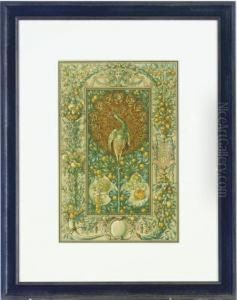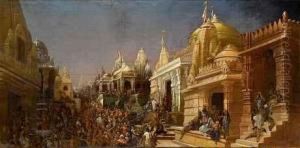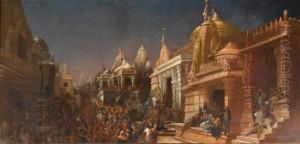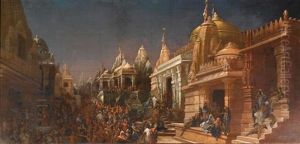Anton Seder Paintings
Anton Seder was a German artist, designer, and professor, best known for his contributions to the Art Nouveau movement, which was known in Germany as Jugendstil. Born in 1850, Seder grew up during a period when the arts were undergoing significant changes across Europe, with new styles and movements emerging as a response to the Industrial Revolution and the associated social transformations.
Seder began his artistic education at the Grand Ducal Saxon Art School in Weimar and later continued his studies at the Academy of Fine Arts Munich. His work was deeply influenced by the natural world, and he had a particular interest in integrating organic forms into decorative art. Throughout his career, Seder was involved in various aspects of art and design, including illustration, interior design, and the decorative arts.
He became a prominent figure in the Art Nouveau movement and was appointed as the director of the School of Applied Arts in Strasbourg, where he played a crucial role in developing the institution's reputation for excellence in the decorative arts. Seder encouraged his students to draw inspiration from nature and to incorporate these elements into their designs, which was a hallmark of the Art Nouveau aesthetic.
Seder's own work often featured elaborate botanical motifs, stylized floral designs, and the sinuous lines that characterized Art Nouveau. He created numerous illustrations for books and periodicals, and his designs were also used for various decorative objects, including wallpapers, textiles, and ceramics.
One of Seder's most significant contributions to the field of art and design was his publication of 'Das Pflanzenornament' (The Plant Ornament), which served as a sourcebook of Art Nouveau designs and was widely used by artists and craftsmen of the time. The book showcased Seder's skill in creating intricate patterns and designs based on natural forms and was influential in spreading the Art Nouveau style.
Anton Seder's impact on the decorative arts extended beyond his personal work. As an educator, he shaped the artistic sensibilities of a generation of designers and artists who would carry the principles of Art Nouveau into their own practices. Seder passed away in 1916, leaving behind a legacy as one of the prominent figures in the movement that championed beauty and craftsmanship in the face of the industrialized world's mass production.



